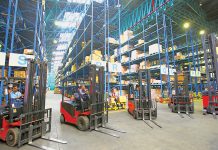Companies that lag on digitalising their supply Chain will be left behind and face further disruption brought on by the uncertain times. Those who invest ahead of the curve, and nurture innovation, agility and connectedness within their supply chain will be well-positioned as the resilient organisations of tomorrow, says Noel Singgih, CIO-APAC, DHL Supply Chain.
Since the start of the millennium, every sector of the economy has been driving towards the digitalisation, automation and connectivity of operations and products and services throughout the global supply chain. Global industries have been adapting to the seismic disruption as a result of the fourth industrial revolution, fuelled by factors, such as the advent of e-Commerce, and massive shifts in consumer demand. While this trajectory and its economic implications were predictable, the pandemic accelerated the global drive to digitalise and helped usher in the future of commerce, trade and logistics much faster than astute experts anticipated.
Unfortunately, challenges arising in transport and supply chain sectors around the globe led to disruption in cross-border movement of goods and services. This is an increasingly complex scenario, exacerbated by ongoing bottlenecks constricting the supply chain of Asia-Pacific region, producing ripple effects across continents. Supply chain bottlenecks, shortages of goods and workers, and a myriad of other challenges will not go away unless production increases or demand diminishes. The latter is unlikely to happen. The former can only be achieved if companies can harness big data, connected devices, automation and an upskilled workforce through
the digitalisation of integrated supply chain networks.
Harnessing data through technology
We have deployed considerable resources towards the digitalisation and automation of our supply chain encompassing a mix of emerging technology, including autonomous vehicles, smart wearables, augmented reality and AI applications. Production facilities are more flexible than ever, and integrated with their equipment and materials, safely engaging a hybrid human-machine workforce to fulfill custom orders at costs comparable to mass production. All along the value chain, big data, sensors and other digital assets are being leveraged to make full and agile use of global transportation networks to deliver orders to your doorstep. By capturing and connecting intelligent data across their business networks, and adapting processes to how digitalised supply chains operate, companies will be better equipped to adapt to new processes and meet the evolving needs of the consumer.
Automation shows the way
The RoI from digitalised supply chains of the future can already be seen today. Research from McKinsey shows companies that digitise their supply chain could see annual earnings growth (EBITA) of 3.2 per cent and revenue growth of 2.3 per cent. A recent survey conducted by DHL Supply Chain, ‘Digitalisation and the Supply Chain’, revealed 82 per cent of companies believe the supply chain digitalisation is having an impact on their business today, which is why the company is investing US$ 2.2 billion in digitalisation and automation initiatives until 2025.
We are establishing our own network of fulfilment centres in 12 cities, such as Mumbai, New Delhi, Ahmedabad, Bengaluru and others. These centres will process both B2B as well as B2C orders. They will be fully automated allowing our customers to have real-time and complete visibility on their orders.
The development of global standards directing how devices communicate, integrate and clear customs will be a critical component that ensures digitalised supply chains are able to harness the growing momentum. Companies also need to strike a balance between leveraging automation efficiencies and ensuring human capital has a continued role to play in operating increasingly complex tasks and new technologies that will comprise the supply chain of the future.













